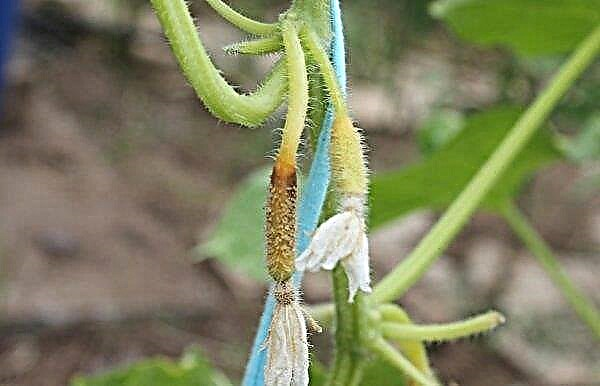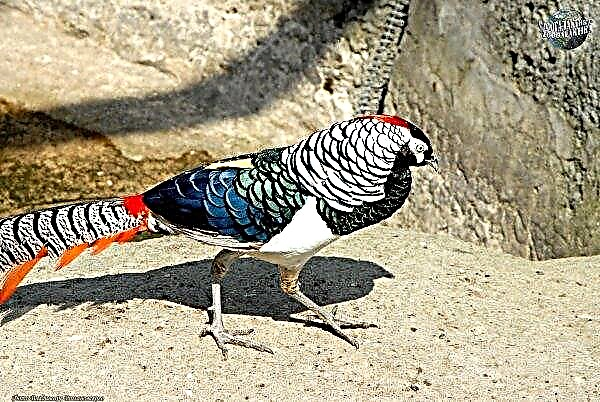Bees grow a new uterus only in case of old age, loss or death already existing. If the beekeeper wants his business to be profitable, he should replenish the number of queens annually and upgrade them to young ones. You can do this by purchasing them from other people or growing them yourself. After reading the article, you will learn how to remove the uterus from the larvae at home and how long this process will take.
What are the basic requirements for bee families
Preparation for withdrawal begins with the selection of the family.
It must meet the following requirements:
- shows high productivity indicators;
- characterized by good health throughout the year;
- tolerates winter well;
- has strong immunity and increased resistance to disease;
- has a large number of nurse bees;
- with honey reserves of 6–8 kg.
Did you know? Archaeological research suggests that bees were “domesticated” by humans 5–6 thousand years ago. They were kept in primitive woven from rods or wooden beehives or clay vessels.
What functions does the uterus perform
The bee family is divided into 3 social groups: the uterus, working bees and drones (males). Also in the hive live young individuals who are just developing. Only working bees fly out of the hive to collect nectar and pollen. They are sterile, their genitals are poorly developed. The uterus is a female with well-developed genital organs, which is engaged in laying eggs and raising offspring, and drones fertilize them.

One female is capable of laying from 1.5 to 3.5 thousand eggs per day. The average life expectancy of the uterus is 3-5 years. While working individuals live on average for 6 weeks, drones - 8. Bees replace the uterus if it is no longer able to lay eggs or dies. In the first case, the old bee stays in the hive until the young one ripens. After that, she is expelled from the bee dwelling or killed.
Usually in apiaries, beekeepers replace the uterus every 1–2 years. The fact is that starting from the age of 2 years, the productivity of queens decreases, and moreover they lay more unfertilized eggs, from which drones appear. All this leads to the fact that the family loses its strength and, accordingly, reduces productivity - it gives less honey. In order for the force to remain at the same level, a uterus replacement is required.
Did you know? A working bee during flight flaps its wings at a frequency of 200 times per minute.
The main conditions for the removal of uterus
For families in which the uterus is planned, long before the process (since early spring) it is necessary to create certain conditions:
- provide them with increased feed;
- provide the best honeycomb;
- make a super-early flyby;
- insulate the hive well;
- feed with honey-pepper dressing;
- create a favorable microclimate inside the hive with an air temperature of + 28 ... + 30 ° C and a humidity of 80–90%.

If the withdrawal is planned for the summer, then you should provide a family with a bribe, load work, expand the nest, and take care of good ventilation. And another important condition for successful hatching is the quality of the larvae. The best females are obtained from larvae 1-3 days old with body sizes from 1.5 to 12.5 mm (weight and size will be different, depending on which breed the larvae belong to).
Calendar dates for the removal of uterus
It is necessary to bring out uterus in the spring and in the first half of summer under favorable weather conditions. After the main bribe, that is, at the end of summer and autumn, you can only do this in the southern regions. In the spring, they do not start the process until the moment the weather is warm and the melliferous plants bloom. It is also necessary to focus on the beginning of the drone brood.
Important! Highly productive females come out if the cross is made in the same breed.
The hatching process can begin 2 weeks after the laying of drone eggs. In the family, at the time of the start of breeding, old individuals should be replaced by young bees. If the beekeeper independently displays bee females, then he should keep a calendar in which to enter the dates, the number of hatched individuals, their pedigree.
Ways to withdraw the uterus: a sequence of actions
In beekeeping, the process of replacing the uterus with a person is called mating. It can be carried out in various ways - to provoke natural hatching, to produce artificial hatching from larvae. The process is not time consuming. However, it will not be easy to implement it from scratch. Successful implementation requires certain knowledge, skills, experience and strict adherence to the recommendations for each of the stages.
Video: withdrawal of queen bees and receiving queen cells
Natural methods
To obtain natural reproduction from bees, the beekeeper needs to provoke this process.
There are two ways to do this:
- Create conditions for swarming: place 3 brood frames in the hive, cover the notch, remove frames that are not used.
- To provoke the deposition of fistulous bees: move the selected uterus from a strong family to another hive simultaneously with two frames with brood and shake the bees out of several frames into it. An orphaned family will begin to create a new queen.
Did you know? Only working bees leave the hive in search of pollen. When one individual finds a place with a large accumulation of nectar, he informs his “colleagues” about it using a special dance - it moves along a closed curve in the form of an eight, wagging its belly.
Artificial conclusion
The artificial conclusion begins with the preparation of larvae. The preparation process is carried out by two methods: they act without transplanting larvae, growing them in mother liquors, or transfer them from cells to bowls. The first method is simpler to execute. For its implementation, a frame with larvae of the same age is placed in the center of the nest of an orphaned family. In the future, the bees will rebuild queen cells there and begin to breed the queens.

The process of transplanting larvae is more time-consuming, not suitable for all apiaries. With it, you will need to make a bowl artificially - from a soft piece of wax and planted on a stick. Then larvae are transferred to it. The bowl is placed in the center of the nest. Her bees will later be converted into a mother liquor.
Other ways
We examined the most popular ways. However, this is not the whole list. For example, females can be hatched in syringes or on vaccination frames, cartridges.
In syringes. A piston is removed from a 20 cc syringe. 4 rows of holes are made, 6 in each row. A hole is made in the piston for attaching the bowl. The excess part of the piston is cut with a knife. Candy balls are lowered to the bottom of the syringe body and breadwinners are placed in it.
Way Alley. Stripes with whole rows are cut from a honeycomb with young larvae using a sharp, calcined knife, and then half of their height is cut. Thinning of larvae is carried out, leaving a pair of empty cells. The next step is to expand the cells. The strips thus prepared are fixed on the frame. In the cell of the frame, 2 holes 4–5 cm high are cut. The strip is glued to the edges of the honeycomb with very warm, but not hot wax. The frame is placed in a family, which will subsequently rebuild the mother cells.
Important! In one hive, several females can develop. The first, which will hatch, will subsequently kill all the others, therefore it is necessary not to miss the moment and timely plant the uterus in other hives, to form layering.
The Zander way. First, prepare the strips, as in the previous method. Then the strips are cut into small pieces containing one larva. These parts are glued with wax to wooden bars-cartridges measuring 25 × 25 mm and attached to the grafting frame of 12-15 rounds. The frame is placed in the family.
Beekeepers mistakes in hatching
For the beginning uterine breeder, the process of hatching bees does not always go smoothly and successfully. The reasons lie in the wrong actions.

The most common mistakes are:
- Breeding without pure breeding material.
- Anxiety of honeycombs with larvae or mother liquor.
- Lack of control over royal jelly during vaccination, as a result of which it dries up.
- Crossbreeding between close relatives.
- Ignoring the creation of an optimal microclimate in the hive.
- The product of interbreeding.
Thus, the uterus is recommended to be replaced at least every 2 years. Highly productive individuals are obtained in strong families, at the right time (during the swarm season, during a bribe), when the necessary conditions are created, the necessary microclimate and the provision of good nutrition in the form of high-quality royal jelly.












